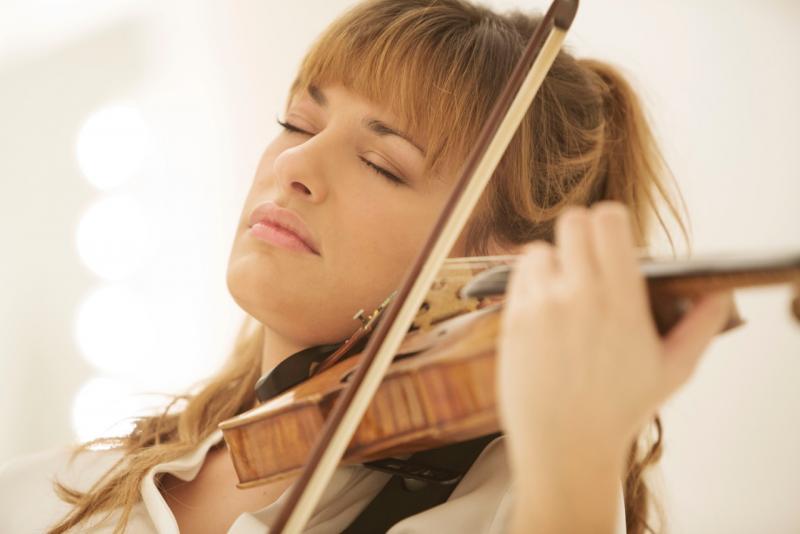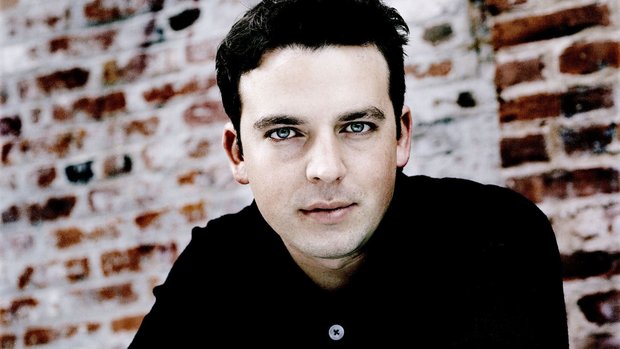Benedetti, LSO, Gaffigan, Barbican | reviews, news & interviews
Benedetti, LSO, Gaffigan, Barbican
Benedetti, LSO, Gaffigan, Barbican
Dazzling premiere for Marsalis’s protracted but feisty new concerto

A full house for a premiere performance: Wynton Marsalis bucks the trend in contemporary music. He’s an established name, more for his jazz than his classical work. But in recent years he has produced a substantial body of orchestral music, so the flocking crowds know what to expect. His new Violin Concerto continues the trend.
The concerto is in four movements, beginning with a peaceful nocturne and gradually building through an animato second movement and a Deep South congregational third to a foot-stomping hoedown finale. Marsalis and Benedetti tell us they collaborated every step of the way, and the violin writing is carefully judged to exploit the best of her playing. The lyrical opening movement needs long, sustained phrases, which Benedetti amply provides. The orchestral textures are often bare (Marsalis gives us proficient orchestration, but it's rarely imaginative), and so the music relies on the sheer tonal character of the violin, and again Benedetti is always able to maintain the interest. She also excels in the more gutsy rhythmic writing. Many of the episodes in the fourth movement hoedown begin in the violin – earthy folk fiddle licks – before being taken up by the orchestra. Each time, Benedetti’s solo entry proved as gutsy and dynamic as the full orchestra that followed.
No doubt the concerto will receive many more performances, but it doesn’t have the feeling of an instant classic. The generally conservative style will probably play better in the States than in Europe, but there is no denying that he writes for an orchestra far larger than the ideas he gives them. And, attractive as many of the episodes are, the work is long and wayward. Indulgences are many, but the most egregious is the second movement cadenza, which never seems to end. Judicious cuts might make it a more attractive proposition, for soloists and audiences alike.
 Conductor James Gaffigan (pictured above by Mat Hennek) and the London Symphony Orchestra devised an excellent all-American programme to frame the concerto, with masterpieces from Stravinsky and Bernstein that were in the spirit of the Marsalis, but without ever competing with it. The second half opened with Stravinsky’s Symphony in Three Movements, perhaps the most American of his orchestral works. It is a tough work to bring off, but Gaffigan’s clear, unfussy technique and carefully controlled dynamics and tempos produced serviceable results. Unfortunately for him, superlative competition is at hand, namely the recording of the LSO’s previous performance, under Gergiev, released on the orchestra’s own label. Against this, Gaffigan’s account lacks rhythmic clarity, and his textures feel weighed down, lacking the fleetness of touch that Gergiev brings to the score.
Conductor James Gaffigan (pictured above by Mat Hennek) and the London Symphony Orchestra devised an excellent all-American programme to frame the concerto, with masterpieces from Stravinsky and Bernstein that were in the spirit of the Marsalis, but without ever competing with it. The second half opened with Stravinsky’s Symphony in Three Movements, perhaps the most American of his orchestral works. It is a tough work to bring off, but Gaffigan’s clear, unfussy technique and carefully controlled dynamics and tempos produced serviceable results. Unfortunately for him, superlative competition is at hand, namely the recording of the LSO’s previous performance, under Gergiev, released on the orchestra’s own label. Against this, Gaffigan’s account lacks rhythmic clarity, and his textures feel weighed down, lacking the fleetness of touch that Gergiev brings to the score.
No such complaints though with Bernstein’s Chichester Psalms, which closed the concert. Gaffigan was in his element here, as was the LSO Chorus, who filled the hall with their bright, warm tone. Excellent balance was maintained between the orchestra and the chorus, even in the loudest climaxes. Good solos from boy treble Ben Hill and the soloists within the choir. All round, this was a bright and joyous climax to the evening.
But it wasn’t the highlight. That came early on with the Bernstein Prelude, Fugue and Riffs, which opened the concert. For this, the LSO regrouped as a big band, with four woodwind players taking up sax, the trumpets and trombones standing behind, a drum kit and string bass at the front, and stage right a piano and clarinet soloist Chris Richards. Again, Gaffigan was in his element, cleanly articulating the cross rhythms and offbeats to a keenly engaged and stylistically alert ensemble. The real stars here, and arguably throughout the evening, were the trumpets and trombones, putting out clean, sharp attacks, with ideal balance within the section and a real feeling for each of the jazz styles. Few orchestras in the world field a brass section that can cook like this.
rating
Share this article
The future of Arts Journalism
You can stop theartsdesk.com closing!
We urgently need financing to survive. Our fundraising drive has thus far raised £49,000 but we need to reach £100,000 or we will be forced to close. Please contribute here: https://gofund.me/c3f6033d
And if you can forward this information to anyone who might assist, we’d be grateful.

Subscribe to theartsdesk.com
Thank you for continuing to read our work on theartsdesk.com. For unlimited access to every article in its entirety, including our archive of more than 15,000 pieces, we're asking for £5 per month or £40 per year. We feel it's a very good deal, and hope you do too.
To take a subscription now simply click here.
And if you're looking for that extra gift for a friend or family member, why not treat them to a theartsdesk.com gift subscription?
more Classical music
 First Person: Manchester Camerata's Head of Artistic Planning Clara Marshall Cawley on questioning the status quo
Five days of free events with all sorts of audiences around Manchester starts tomorrow
First Person: Manchester Camerata's Head of Artistic Planning Clara Marshall Cawley on questioning the status quo
Five days of free events with all sorts of audiences around Manchester starts tomorrow
 Goldscheider, Brother Tree Sound, Kings Place review - music of hope from a young composer
Unusual combination of horn, strings and electronics makes for some intriguing listening
Goldscheider, Brother Tree Sound, Kings Place review - music of hope from a young composer
Unusual combination of horn, strings and electronics makes for some intriguing listening
 theartsdesk Q&A: composer Donghoon Shin on his new concerto for pianist Seong-Jin Cho
Classical music makes its debut at London's K-Music Festival
theartsdesk Q&A: composer Donghoon Shin on his new concerto for pianist Seong-Jin Cho
Classical music makes its debut at London's K-Music Festival
 Helleur-Simcock, Hallé, Wong, Bridgewater Hall, Manchester review - moving lyricism in Elgar’s concerto
Season opener brings lyrical beauty, crisp confidence and a proper Romantic wallow
Helleur-Simcock, Hallé, Wong, Bridgewater Hall, Manchester review - moving lyricism in Elgar’s concerto
Season opener brings lyrical beauty, crisp confidence and a proper Romantic wallow
 Kohout, Spence, Braun, Manchester Camerata, Huth, RNCM, Manchester review - joy, insight, imagination and unanimity
Celebration of the past with stars of the future at the Royal Northern College
Kohout, Spence, Braun, Manchester Camerata, Huth, RNCM, Manchester review - joy, insight, imagination and unanimity
Celebration of the past with stars of the future at the Royal Northern College
 Jansen, LSO, Pappano, Barbican review - profound and bracing emotional workouts
Great soloist, conductor and orchestra take Britten and Shostakovich to the edge
Jansen, LSO, Pappano, Barbican review - profound and bracing emotional workouts
Great soloist, conductor and orchestra take Britten and Shostakovich to the edge
 Jakub Hrůša and Friends in Concert, Royal Opera review - fleshcreep in two uneven halves
Bartók kept short, and a sprawling Dvořák choral ballad done as well as it could be
Jakub Hrůša and Friends in Concert, Royal Opera review - fleshcreep in two uneven halves
Bartók kept short, and a sprawling Dvořák choral ballad done as well as it could be
 Hadelich, BBC Philharmonic, Storgårds, Bridgewater Hall, Manchester review - youth, fate and pain
Prokofiev in the hands of a fine violinist has surely never sounded better
Hadelich, BBC Philharmonic, Storgårds, Bridgewater Hall, Manchester review - youth, fate and pain
Prokofiev in the hands of a fine violinist has surely never sounded better
 Monteverdi Choir, ORR, Heras-Casado, St Martin-in-the-Fields review - flames of joy and sorrow
First-rate soloists, choir and orchestra unite in a blazing Mozart Requiem
Monteverdi Choir, ORR, Heras-Casado, St Martin-in-the-Fields review - flames of joy and sorrow
First-rate soloists, choir and orchestra unite in a blazing Mozart Requiem
 Cho, LSO, Pappano, Barbican review - finely-focused stormy weather
Chameleonic Seong-Jin Cho is a match for the fine-tuning of the LSO’s Chief Conductor
Cho, LSO, Pappano, Barbican review - finely-focused stormy weather
Chameleonic Seong-Jin Cho is a match for the fine-tuning of the LSO’s Chief Conductor
 Classical CDs: Shrouds, silhouettes and superstition
Cello concertos, choral collections and a stunning tribute to a contemporary giant
Classical CDs: Shrouds, silhouettes and superstition
Cello concertos, choral collections and a stunning tribute to a contemporary giant
 Appl, Levickis, Wigmore Hall review - fun to the fore in cabaret and show songs
A relaxed evening of light-hearted fare, with the accordion offering unusual colours
Appl, Levickis, Wigmore Hall review - fun to the fore in cabaret and show songs
A relaxed evening of light-hearted fare, with the accordion offering unusual colours

Add comment